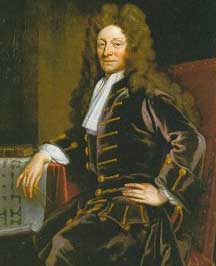Sir Christopher Wren Biography
A short biography of Christopher Wren with some anecdotal and interesting information which details the influence of Wren on English furniture of the William and Mary era.
In the William and Mary period two important personal influences were stimulating and educating taste, and the work of Sir Christopher Wren and Daniel Marot is so important that some understanding of its quality and character is essential if a clear view is to be gained of the taste of the period as a whole.

Christopher Wren Picture, 1711.
Wren - Mathematician, Artist, Humorist
Sir Christopher Wren was that rare combination, a mathematician and an artist, and also something of a humorist if the story about the building of the town hall at Windsor is true and there is no reason why legends should always be considered merely legends.
The Humour of Wren
The Windsor town hall was built in 1688, with a large ground floor space which did duty as a corn exchange, the first floor being occupied by the great hall. As ignorance and self-sufficiency have apparently always been considered good qualifications for civic dignities, the town councillors (or rather burghers) of Windsor in that far off time naturally sought to instruct the designer of St Paul's in basic architecture. The beams he had put in to support the floor of the great hall were not, they opined, strong enough to support the weight that they would have to bear. The walls would collapse; the beams would break, and so forth.
Wren's method of dealing with such idiocy was tactful, but enriched with the ironic touch that shows long vision and sly humour. He told the burghers that he would place columns as additional supports where the beams intersected; and he did, but he built them a matter of two inches short, and there they have stood below the ceiling they were supposed to support for more than two centuries, a lasting monument to the triumph of technical ability over timorous absurdity.
Classical Architecture

Powder House, Williamsburg, Virginia. Built in public square under supervision of Gov. Spotwood, octagonal in form, of solid brick. Designed by Sir Christopher Wren.
Wren carried on and developed the classical taste that Inigo Jones had expressed in his work, and as a maker of churches and palaces he left a lasting mark upon the architecture of his own time, and stimulated and enriched the inspiration of the generation of architects that followed him.
Influence of Furniture Design
In establishing a widespread regard for the beauty of correct proportions in classic architecture he did much towards the final abolition of caricature both in decoration and furniture making, and the exact significance of the influence of real knowledge of the proportions of classic architecture may be judged by looking at some such piece as the writing cabinet of early eighteenth century origin signed, "Samuel Bennett, London, Fecit," that was acquired by the Victoria and Albert Museum in June 1924, and which is strongly architectural in character, the upper part being framed with fluted pilasters and panels of inlaid ornament. Then compare it with any of the early seventeenth century four post beds in which architectural features are introduced and handled without sympathy or knowledge of the balance and exquisite proportion of classic architecture. The Samuel Bennett cabinet could not possibly have been produced by a craftsman who had not enjoyed the advantages of education and example in architecture and decoration.
It was particularly fortunate for taste in Britain that a man of Wren's accomplishments and wide knowledge should have been given the opportunity of influencing the ideas of his time with so much fine work. Evelyn has given us an occasional glimpse of Wren as a young man ; he is referred to as "that miracle of a youth, Mr Christopher Wren, nephew of the Bishop of Ely" and in the entry of his Diary for 13th July 1654 we have the following picture, not without its interest if we would know something of Wren's special genius, and the early surroundings in which it was developed:
We all dined at that most obliging and universally curious Dr Wilkins's, at Wadham College. He was the first who showed me the transparent apiaries, which he had built like castles and palaces, and so ordered them one upon another as to take the honey without destroying the bees. These were adorned with a variety of dials, little statues, vanes, etc., and he was so abundantly civil, as finding me pleased with them, to present me with one of the hives which he had empty, and which I afterwards had in my garden at Sayes Court, where it continued many years, and which his Majestic came on purpose to see and contemplate with much satisfaction.
He had also contrived an hollow statue which gave a voice and uttered words, by a long concealed pipe that went to its mouth, whilst one speaks through it at a good distance. He had above in his lodgings and gallery variety of shadows, dials, perspectives, and many other artificial, mathematical, and magical curiosities, a way-wiser, a thermometer, a monstrous magnet, conic and other sections, a ballance on a demi-circle, most of them of his own and that prodigious young scholar Mr Christopher. Wren who presented me with a piece of white marble, which he had stained with a lively red very deep, as beautiful as if it had been natural.

St Paul's, north west view.
The work of Wren remains popular today with much interest in Wren house plans and Wren style homes.
